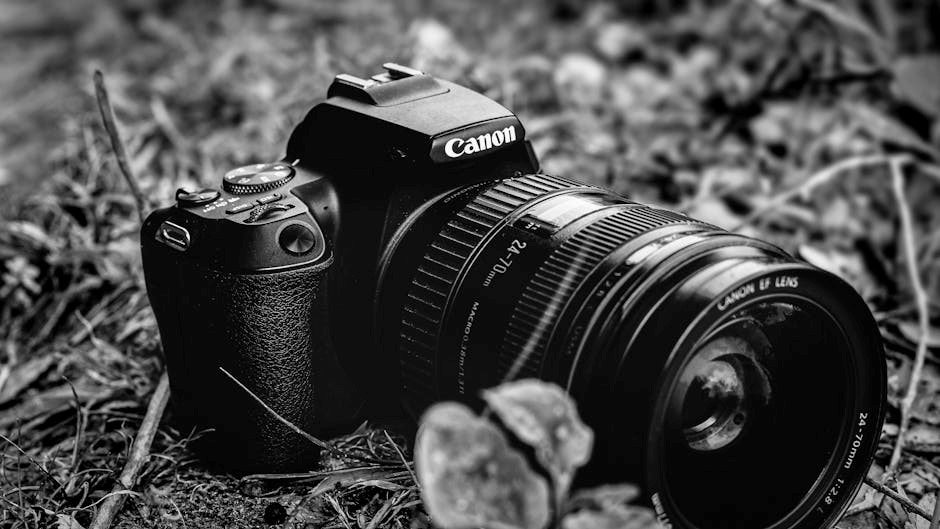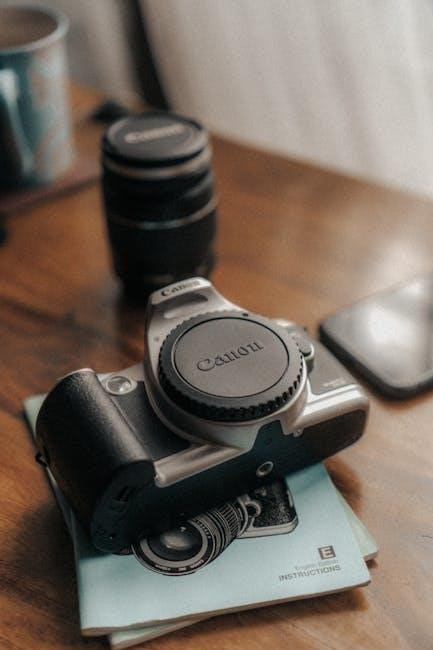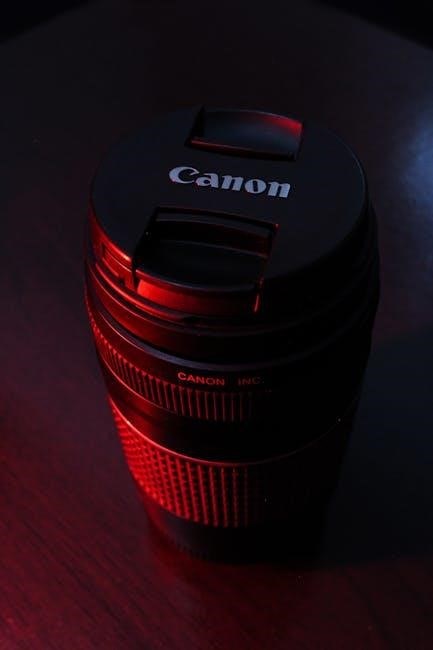canon 60d instruction manual
The Canon EOS 60D is a high-tech DSLR camera designed for photography enthusiasts and professionals. It features an 18.0 MP CMOS sensor, vari-angle LCD, and Full HD video capabilities, making it a versatile tool for capturing high-quality images and videos. This manual provides a comprehensive guide to understanding and utilizing the camera’s advanced features effectively.
1.1 Overview of the Canon EOS 60D Camera
The Canon EOS 60D is a high-performance DSLR camera designed for enthusiasts and professionals. It features an 18.0 MP CMOS sensor, vari-angle 3.0″ Clear View LCD, and Full HD video recording. With built-in wireless flash control and customizable settings, it offers versatility for various photography needs. The camera combines advanced technology with user-friendly controls, making it ideal for capturing high-quality images and videos in diverse lighting conditions. Its durable construction and intuitive interface ensure a seamless shooting experience for photographers of all skill levels.
1;2 Importance of the Instruction Manual
The instruction manual is essential for understanding the Canon EOS 60D’s features and optimizing its performance. It provides detailed guidance on camera settings, shooting modes, and troubleshooting. Whether you’re a beginner or an advanced photographer, the manual helps you master the camera’s capabilities, ensuring you don’t miss out on its advanced functions. It also covers maintenance, firmware updates, and customization options, enabling you to maximize the camera’s potential and achieve professional-quality results consistently.

Key Features of the Canon EOS 60D
The Canon EOS 60D boasts an 18.0 MP CMOS sensor, vari-angle LCD, Full HD video recording, and wireless flash control, making it a powerful tool for photographers;
2.1 High-Resolution 18.0 Megapixel CMOS Sensor
The Canon EOS 60D features an 18.0 megapixel CMOS sensor, delivering exceptional image quality with precise detail and vibrant colors. This sensor captures high-resolution images, ideal for enlargements and cropping. Its APS-C size ensures a 1.6x crop factor, enhancing lens versatility. The CMOS technology provides excellent low-light performance, reducing noise and ensuring crisp photos even in challenging lighting conditions. This feature is a cornerstone of the camera’s ability to produce professional-grade imagery.
2.2 Vari-Angle 3.0″ Clear View LCD Screen
The Canon EOS 60D boasts a 3.0″ Vari-Angle Clear View LCD screen with 1,040,000 dots, offering exceptional clarity and color accuracy. The articulating design allows for flexible shooting from various angles, making it ideal for both still photography and video recording. The screen’s wide viewing angle ensures accurate composition, even in bright lighting conditions. Its smudge-resistant coating minimizes fingerprints, maintaining image visibility. This feature enhances creativity and convenience, enabling photographers to capture stunning shots in diverse situations.
2.3 Full HD Video Recording Capabilities
The Canon EOS 60D supports Full HD video recording at 1080p resolution, capturing smooth motion and rich details. It offers frame rates of 24, 25, and 30 fps for cinematic and broadcast-quality results. Manual sound recording is available, allowing precise audio control, while silent shooting in Movie mode minimizes disruptions. The camera also features a dedicated movie mode button for quick access, making it a versatile tool for both photographers and videographers to create professional-grade content with ease and precision.
2.4 Built-In Wireless Flash Control
The Canon EOS 60D features built-in wireless flash control, enabling seamless communication with compatible external Speedlites. This functionality allows photographers to adjust flash settings and trigger off-camera units without additional cables, enhancing creative lighting control. The wireless system supports multiple flash groups, providing flexibility for complex lighting setups. This feature is particularly useful for capturing dynamic portraits and scenes with precise illumination, making it a valuable tool for both amateur and professional photographers seeking advanced lighting solutions.

First-Time Setup and Configuration
Unpack, charge, and prepare your Canon EOS 60D for initial use. Familiarize yourself with the camera’s layout and essential settings to ensure a smooth start.
3.1 Unpacking and Initial Inspection
Unpack the Canon EOS 60D carefully, ensuring all accessories are included: camera body, battery, charger, neck strap, and user manual. Inspect the camera for any visible damage. Familiarize yourself with the external features, such as the mode dial, vari-angle LCD screen, and external ports. Charge the battery fully before first use. Perform a quick lens inspection and clean if necessary. Verify the camera’s serial number matches the manual for authenticity. This initial check ensures your camera is ready for proper setup and use.
3.2 Charging the Battery and Installing the Memory Card
Insert the battery into the charger and plug it into a power source. Allow it to charge fully, indicated by a green light. Once charged, insert the battery into the camera’s battery compartment. Next, locate the memory card slot on the camera’s side. Open the compartment door, insert your SD or SDHC card, and close it securely. Ensure the card is compatible with the camera and formatted properly. Turn on the camera to confirm the battery is recognized and the memory card is ready for use. This step ensures your camera is prepared for capturing images.
3.3 Mounting the Lens and Basic Camera Handling
To mount the lens, align the white dot on the lens with the white dot on the camera mount. Press the lens release button and twist the lens clockwise until it clicks. Ensure it is securely locked. When handling the camera, grip it firmly with one hand under the lens and the other holding the body. Use the strap for added security. Avoid touching the LCD screen to prevent smudges. Store the camera in a protective case when not in use and keep the lens cap on to prevent damage.

Navigating the Menu System
The Canon EOS 60D menu system offers an intuitive interface for accessing shooting settings. Use the Quick Control Dial to navigate and select options efficiently.
4.1 Understanding the Menu Structure
The Canon EOS 60D menu system is divided into tabs for easy navigation. Press the MENU button to access settings like Shooting, AF, and Setup. Use the Quick Control Dial to scroll through options and the SET button to select. The menu structure is intuitive, allowing quick adjustments to camera settings such as image quality, autofocus modes, and custom functions. Each tab is organized to streamline workflow, ensuring efficient access to the features you need for optimal photography.
4.2 Customizing Menu Options for Personalized Shooting
Customizing menu options on the Canon EOS 60D allows you to tailor settings to your shooting style. Use the Quick Control Dial to navigate and the SET button to select. Assign frequently used functions to buttons like the M-Fn button for quick access. Create custom shooting modes (C1, C2, C3) to save specific configurations. This feature streamlines your workflow and enhances efficiency during photo sessions. Additionally, you can register up to six frequently used menu items in the My Menu tab for easy access.

Shooting Modes and Settings
The Canon EOS 60D offers a variety of shooting modes to suit different skills and scenarios. From Auto Mode to manual control, these settings provide flexibility for capturing images precisely as desired. This section explores the range of modes and how to adjust settings for optimal results in various photography situations.
5.1 Auto Mode for Beginners
Auto Mode on the Canon EOS 60D is designed for beginners, offering a user-friendly experience by automatically adjusting settings like aperture, shutter speed, and ISO. This mode is ideal for those new to photography, as it eliminates the need to manually adjust controls. The camera detects the scene and optimizes settings for the best possible result. It also automatically enables the flash when necessary. By using Auto Mode, beginners can focus on composition and creativity while the camera handles technical details. This mode serves as a stepping stone to more advanced shooting techniques.
5.2 Creative Zone Modes (P, TV, AV, M)
The Creative Zone Modes (P, TV, AV, M) offer advanced control for photographers seeking more creative freedom. Program Auto (P) balances aperture and shutter speed while allowing adjustments. Shutter Priority (TV) lets you set shutter speed to freeze or blur motion. Aperture Priority (AV) enables control over depth of field by adjusting the aperture. Manual (M) mode provides full control over both aperture and shutter speed for precise results. These modes are ideal for photographers who want to explore beyond automatic settings and refine their creative vision.
5.3 Custom Shooting Modes (C1, C2, C3)
The Canon EOS 60D offers three Custom Shooting Modes (C1, C2, C3) that allow you to save personalized camera settings. These modes let you tailor settings like aperture, shutter speed, ISO, and white balance to suit specific shooting scenarios. Once configured, they can be quickly accessed for consistent results. This feature is ideal for photographers who frequently shoot under similar conditions or prefer a customized workflow. It enhances efficiency and ensures optimal image capture tailored to individual preferences. These modes are a powerful tool for refining your photography style.
Image Quality and File Formats
The Canon EOS 60D delivers high-quality images with its 18.0 MP CMOS sensor, supporting both JPEG and RAW file formats for flexibility in post-processing and detail retention.
6.1 Setting Image Resolution and Compression
The Canon EOS 60D allows users to set image resolution and compression levels to suit their needs. Resolution can be adjusted to 18.0 MP (5184 x 3456 pixels) or lower, depending on the intended use. Compression options include Fine, Normal, or Basic JPEG settings, offering a balance between file size and image quality. Use the Basic menu to quickly edit images. RAW format retains maximum detail for post-processing. Adjust compression levels to optimize storage and quality, ensuring the best results for your photography projects.
6.2 Understanding RAW vs. JPEG File Formats
The Canon EOS 60D offers two primary file formats: RAW and JPEG. RAW files store all captured image data, providing maximum flexibility for post-processing. They are ideal for professionals who require precise control over editing. JPEG files, however, are compressed and processed in-camera, resulting in smaller file sizes but limited editing capabilities. Choose RAW for high-quality, editable images or JPEG for convenience and efficient storage. This feature allows photographers to tailor their workflow to their specific needs and preferences.

Focusing and Metering
The Canon EOS 60D features an advanced Autofocus system with high-speed focusing and AF point selection for precise subject capture. Metering modes include Evaluative, Center-Weighted, and Spot for accurate exposure control.
7.1 Autofocus Modes and AF Point Selection
The Canon EOS 60D offers multiple Autofocus modes, including One-Shot AF for stationary subjects and AI Servo AF for continuous tracking of moving subjects. The camera features 9 cross-type AF points, allowing for precise control over focus placement. Users can manually select individual AF points or use automatic AF point selection, enhancing flexibility. Customizable AF settings ensure optimal performance in various shooting conditions, making it ideal for both stills and dynamic photography.
7.2 Metering Modes (Evaluative, Center-Weighted, Spot)
The Canon EOS 60D features three metering modes to cater to various lighting conditions. Evaluative metering analyzes the entire scene, ensuring balanced exposure by considering multiple factors like brightness and color. Center-Weighted metering prioritizes the central area of the frame, ideal for portraits. Spot metering measures light from a small, selectable area, perfect for precise control in high-contrast situations. These modes allow photographers to adapt to diverse lighting environments, ensuring optimal exposure for their subjects.

White Balance and ISO Settings
White Balance adjusts color accuracy based on lighting conditions, while ISO settings manage sensitivity for optimal image quality in varying brightness levels and noise control.
8.1 Adjusting White Balance for Different Lighting Conditions
The Canon EOS 60D offers multiple White Balance options to match various lighting scenarios. Options include Auto, Daylight, Shade, Tungsten, Fluorescent, and Custom settings. Each preset ensures accurate color reproduction by compensating for the color temperature of the light source. For precise control, the Custom White Balance feature allows users to set a specific color temperature using a reference object. This flexibility ensures natural-looking images in diverse lighting environments, enhancing overall image quality and visual appeal.
8.2 Managing ISO Sensitivity for Optimal Image Quality
ISO sensitivity on the Canon EOS 60D ranges from 100 to 6400, with an expandable option up to 12800. Lower ISO settings (e.g., ISO 100-400) are ideal for bright lighting conditions, producing images with minimal noise. Higher ISOs (e.g., ISO 800-6400) are better suited for low-light scenarios but may introduce grain. To maintain image quality, use the lowest necessary ISO and enable noise reduction features if needed. Proper ISO management ensures sharp, detailed, and noise-free results in various shooting environments.

Flash and External Accessories
The Canon EOS 60D includes a built-in flash for easy lighting and supports external Speedlites and accessories for advanced control. The manual offers setup guidance.
9.1 Using the Built-In Flash
The Canon EOS 60D features a built-in flash with a guide number of 12 (ISO 100). It automatically pops up and fires in low-light conditions. To activate it manually, press the flash button on the front. The flash can be adjusted in E-TTL II, Manual, or Multi-flash modes for precise control. Use the Quick Control screen to set flash exposure compensation for balanced lighting. The built-in flash also supports wireless control of external Speedlites, enabling advanced lighting setups. Always ensure the flash is enabled in the camera menu before use for optimal performance.
9.2 Connecting External Speedlites and Accessories
To enhance creativity, the Canon EOS 60D supports external Speedlites and accessories. Use the built-in flash as a wireless controller for compatible Speedlites, enabling off-camera lighting. Connect external flashes via the hot shoe or wireless mode for advanced setups. Accessories like remote controllers and grips can also be attached. Ensure compatibility with Canon’s wireless flash system for seamless integration. Always update firmware for optimal performance and test connections before shooting to avoid issues. This expands the camera’s capabilities for professional-grade lighting and control.

Video Recording and Movie Mode
The Canon EOS 60D offers Full HD video recording with manual controls for exposure and sound. It supports frame rates of 24, 25, and 30 fps, and allows for external microphone use, enhancing audio quality in videos.
10.1 Recording Full HD Video
The Canon EOS 60D captures stunning Full HD video at 1080p with frame rates of 24, 25, and 30 fps. To begin recording, set the camera to Movie Mode using the mode dial. Navigate to the Movie Settings menu to select resolution, frame rate, and enable manual sound recording for better audio control. Use the vari-angle LCD to frame shots comfortably. External microphones can be connected for enhanced sound quality, ensuring professional-grade video production. Proper lighting and stabilization are key to achieving optimal results.
10.2 Manual Sound Recording and Silent Shooting
The Canon EOS 60D allows for manual sound recording, enabling precise audio control during video capture; To activate this feature, navigate to the Movie Settings menu and select Manual Sound Recording. This option is ideal for capturing high-quality audio with external microphones. Silent Shooting mode minimizes camera noise, making it ideal for discreet filming environments. Ensure manual focus is used to avoid lens noise during recording. These features enhance flexibility and creativity in video production, catering to both casual and professional videographers. Proper setup ensures optimal audio and visual results.
Customizing the Camera
Customize your Canon EOS 60D to suit your preferences. Assign functions to buttons, create personalized shooting modes, and tailor settings for enhanced shooting experiences and efficiency.
11.1 Assigning Functions to Buttons
The Canon EOS 60D allows you to assign custom functions to buttons, enhancing your shooting experience. Use the Multi-controller or other buttons to assign tasks like AF Lock, Metering Mode, or Image Rating. This customization streamlines workflows, giving quick access to frequently used settings. By personalizing button functions, you can adapt the camera to your shooting style, improving efficiency and creativity. This feature is particularly useful for photographers who prefer tailored controls for specific tasks, ensuring intuitive operation during photo sessions.
11.2 Creating and Managing Custom Shooting Modes
The Canon EOS 60D allows you to create and manage custom shooting modes (C1, C2, C3) to suit your photography style. These modes enable you to save specific settings like aperture, shutter speed, ISO, and white balance for quick access. To create a custom mode, configure your desired settings, then save them via the menu. Saved modes can be easily accessed using the Mode Dial, offering a seamless way to adapt to different shooting scenarios and streamline your workflow for enhanced creativity and efficiency.

Troubleshooting Common Issues
Resolve camera errors by restarting or updating firmware. Check memory card compatibility and ensure proper formatting. Address connectivity issues by restarting the device or re-establishing connections.
12.1 Resolving Camera or Memory Card Errors
If the camera or memory card malfunctions, restart the device and ensure the card is properly formatted. Check for firmware updates and reformat the memory card if necessary. Verify card compatibility and avoid using damaged cards. If issues persist, reset the camera to default settings or contact Canon support for further assistance. Always handle memory cards with care to prevent data loss and ensure proper functioning of the camera.
12.2 Fixing Connectivity and Firmware Update Problems
To resolve connectivity issues, ensure the camera is properly connected to the computer using a compatible USB cable. Restart both devices and check for stable connection. For firmware updates, use Canon’s EOS Utility software to download and install the latest version. If updates fail, reset the camera to default settings and retry. Ensure the memory card is formatted correctly and avoid interrupting the update process. If issues persist, refer to the user manual or contact Canon support for further assistance.
Updating Firmware and Software
Update firmware and software using Canon’s EOS Utility. Check for updates via the Canon website and download the latest versions to ensure optimal camera performance and functionality.
13.1 Checking for Firmware Updates
To check for firmware updates, connect your Canon EOS 60D to a computer via USB. Open the EOS Utility software and navigate to the “Camera/Update Firmware” menu. The software will automatically detect and display any available updates. Ensure your camera battery is fully charged before proceeding with the update process to avoid any interruptions; Always download updates from Canon’s official website to ensure authenticity and compatibility. Regular firmware updates enhance camera performance and add new features. Follow on-screen instructions carefully to complete the update successfully.
13.2 Installing Firmware and Software Updates
Once updates are detected, download the firmware file from Canon’s official website. Run the downloaded file and follow the on-screen instructions to begin the installation. Ensure the camera is connected to the computer via USB and powered on. Select the EOS 60D from the device list and confirm the update. Do not disconnect the camera or turn it off during the process. Wait for the update to complete and confirm the installation was successful. Restart the camera to apply the new firmware and software updates.
The Canon EOS 60D offers a powerful combination of advanced features and user-friendly design. With its 18.0 MP sensor and Full HD video capabilities, it delivers exceptional results. By exploring its settings and experimenting with techniques, photographers can unlock its full potential and capture stunning images.
14.1 Summary of Key Features and Capabilities
The Canon EOS 60D is a versatile DSLR camera featuring an 18.0 MP CMOS sensor, offering high-resolution imaging and excellent low-light performance. It boasts a vari-angle 3.0″ Clear View LCD, enabling flexible shooting from various angles. The camera supports Full HD video recording, manual sound control, and silent shooting for cinematic experiences. Additional features include built-in wireless flash control, customizable shooting modes, and advanced autofocus and metering systems. These capabilities make the EOS 60D a powerful tool for both photography enthusiasts and professionals, ensuring high-quality results across diverse shooting scenarios.
14.2 Encouragement to Explore and Experiment
With the EOS 60D, the possibilities for creative expression are endless. Experiment with different shooting modes, customize settings, and explore advanced features to tailor your photography experience. Dive into video recording, manual controls, and wireless flash options to unlock new creative dimensions. Don’t hesitate to try new techniques—each shot is an opportunity to learn and grow. Take advantage of the camera’s versatility and personalize it to suit your style, ensuring every moment captured is a reflection of your unique vision and creativity.
